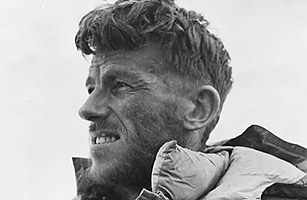
(3 of 7)
How many mountains were there?
This was one of the great pleasures, really: We were in an area where almost nobody had done any climbing, and we made six first ascents of mountains over 20,000 feet. That sort of experience is very difficult to come by these days. There are still lots of mountains around, but all the big ones have been done. Reinhold Messner was the first to reach the summit of all the 8,000-meter peaks [a feat the Italian mountaineer completed in 1986].
You were known as an aggressive climber in your Himalayan years.
I was quite competitive, and I tended to compete with members of my own expedition. I don't think I was unpleasantly aggressive, but I think I rather enjoyed grinding my companions into the ground on a big hill.
I remember when [Everest expedition leader] John Hunt and I were walking in from Kathmandu to Everest, we crossed over a river and had to climb up a very long, steep hill. We were going to camp at the top of the hill. I always used to enjoy going fast up these hills, and at one stage I caught up to John, who was about a decade older than I was. I passed him. John was very, very competitive, and even though he was older than me, he really put on the pace to try and pass me again. Well, there was simply no way I would permit anybody to pass me, and I put on the speed and left John behind. I always remember looking behind at John, who was absolutely desperate to try and defeat me on this hill, and I really couldn't understand it. Here was the leader of the expedition, the big wheel, why should he be so desperately keen to beat someone who was a great deal younger than he was?
I was physically strong back then, and I acclimatized well, and I had quite a competitive spirit. Technically, I was a good snow-and-ice technician, as far as the standards in those days went. I was a good step-cutter and could climb incredible snow and ice pretty effectively. Things have changed so much that the technical ability of people like Messner is greatly superior to anything that we had. But I wouldn't say the modern mountaineer is any stronger, and he certainly is not more strongly motivated.
The Everest expedition was, by the standards of the day, a very professional one.
I think it was well organized, but I wouldn't have said we were very heavily funded. We were a relatively small expedition.
How many were you?
There were really only 11 foreign climbing members, and then Tenzing, who became a climbing member. So there were really only 12 of us who were climbing Everest, and there were three other people — there was the film cameraman, the doctor and James Morris, the press bloke. So there were only 14 or 15 of us. After us came those really huge expeditions: the Japanese and Italian expeditions, with 50 or 60 people on them and vast numbers of Sherpas. Ours was nothing compared to what came afterwards.
And you were in a competition?
It was definitely a race, and all eyes were on it. The Swiss had two attempts scheduled in spring and autumn of '52, and we were in the mountains climbing around and listening for news. We were really quite concerned as to whether or not the Swiss would be successful. We didn't wish them any harm at all, we were quite respectful of them really. But we just hoped that they wouldn't be successful getting to the top.
The Swiss put in a particularly good effort, getting to 28,000 feet. That's when Tenzing really came into his own. He teamed up with [Raymond] Lambert, and Lambert and Tenzing were a pretty formidable combination.
Postmonsoon, the Swiss had bad weather and didn't get as high.
How did you and Tenzing become a team in '53?
The person I really enjoyed climbing with most was George Lowe, and I still believe that if George and I had been in the final summit push, we would have made it because we were a very strong combination. But John decided George and I were both useful as snow-and-ice climbers, and he split us up and used us with different groups. So I realized I simply wasn't going to be able to climb with George. I looked around and decided that the best and fastest mover around the place, apart from myself, was Tenzing.
I remember once, at lower altitudes, going up to this pass. On the walk up, Tenzing and I really raced up to the pass. I beat him to it. But he was obviously very fit, very strong and I was impressed. Tenzing was very competitive too, he wanted to be up front. That was a good sign. And he was a good, sound mountaineer. He had been on quite a few Everest expeditions. He really started as just an ordinary porter on the north side of Everest, and then, since he was obviously strong and accomplished, he became a very useful technical climber as well.